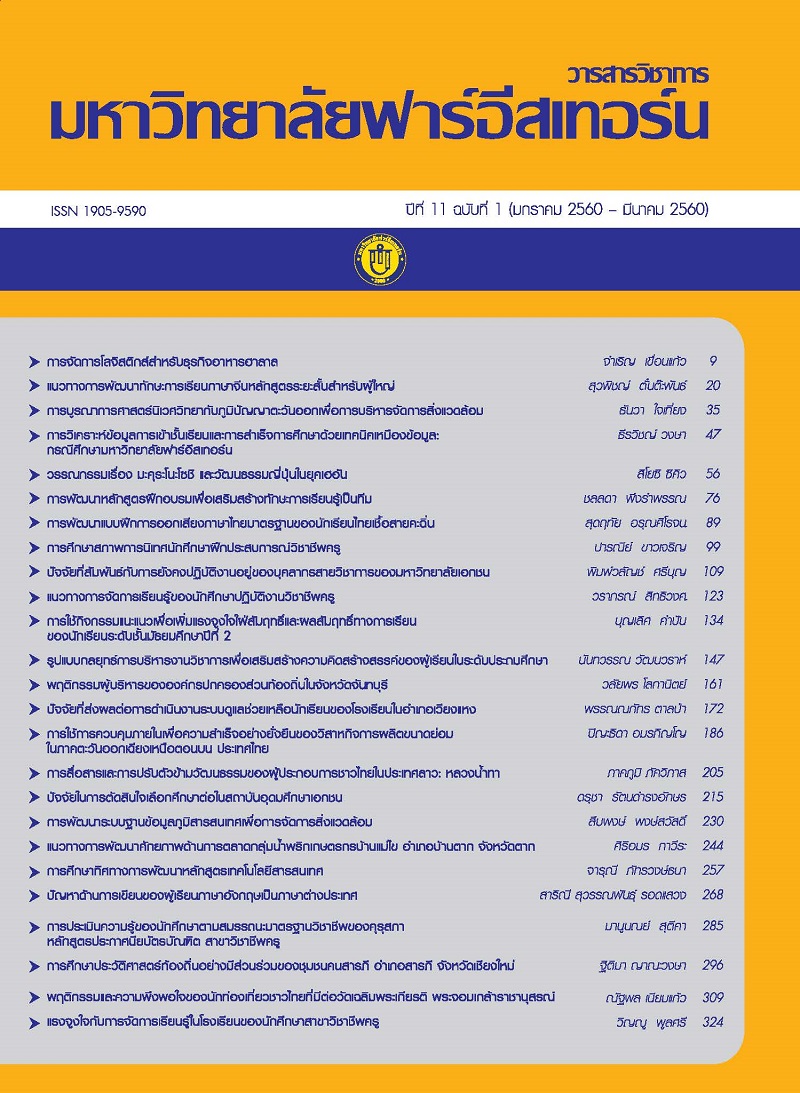แรงจูงใจกับการจัดการเรียนรูใ้ นโรงเรียนของนักศึกษาสาขาวิชาชีพครู คณะศึกษาศาสตร์ มหาวิทยาลัยฟาร์อีสเทอร์น จังหวัดเชียงใหม่
Main Article Content
Abstract
การวิจยั ครงั้ นมี้ วี ตั ถุประสงคเ์ พอื่ ศึกษาแรงจูงใจกับการจัดการเรียนรูใ้ นโรงเรียนของนักศึกษาหลักสูตร
ประกาศนียบัตรบัณฑิต สาขาวิชาชีพครู คณะศึกษาศาสตร์ มหาวิทยาลัยฟาร์อีสเทอร์น เชียงใหม่ ปีการศึกษา
2559 ที่ลงทะเบียนในรายวิชาปรัชญาการศึกษาและจิตวิทยาสำหรับครู จำนวน 180 คน ทำการเก็บข้อมูล
จากนักศึกษาโดยใช้แบบสอบถามศึกษาความสัมพันธ์ของตัวแปรเชิงคุณภาพของนักศึกษา วิเคราะห์ข้อมูล
โดยการจัดอันดับความสำคัญของแรงจูงใจในการจัดการเรียนรู้ในโรงเรียนของนักศึกษา และระดับ
ความสัมพันธ์จากค่าสัมประสิทธิ์ความสัมพันธ์แบบลำดับที่ของสเปียร์แมน (Spearman’s Rank Correlation
Coefficient)
ผลการวิจัยพบว่า 1) อันดับความสำคัญของแรงจูงใจในการเรียนรู้ในโรงเรียนของนักศึกษา ได้แก่
การให้รางวัล การให้เป็นคะแนน การพูดชมเชย การแข่งขันระหว่างนักเรียนในห้อง (แข่งกับกลุ่มที่คละกัน)
และการใช้เทคนิควิธกี ารสอนทจี่ งู ใจ 2) ระดับแรงจูงใจในการจัดการเรียนรูข้ องนักศึกษาสาขาวิชาชีพครูใชว้ ธิ ี
การส่งเสริมให้นักเรียนเกิดแรงจูงใจในการเรียนประกอบด้วย ด้านการแข่งขันระหว่างกลุ่ม (กลุ่มคละเก่ง
ปานกลาง อ่อน) ด้านการเพียรพยายาม (ไม่ละทิ้งการเรียนเมื่อเผชิญกับความยากลำบาก) และด้านก่อให้เกิด
เสริมพลังอำนาจ เช่น มีกำลังใจในการทำงานยิ่งขึ้น 3) ความสัมพันธ์ของตัวแปรการจัดการเรียนการสอน
ที่นักศึกษาได้เลือกใช้เพื่อส่งเสริมให้นักเรียนเกิดแรงจูงใจพบว่า การให้ความสำเร็จในการเรียน การให้รู้จัก
วัตถุประสงค์ของการเรียนและการสร้างบรรยากาศในชั้นเรียน มีความสัมพันธ์กันอย่างมีนัยสำคัญทางสถิติ
(P<0.01) โดยมีค่าสัมประสิทธิ์สหสัมพันธ์ตั้งแต่ .006 - .366 ส่วนการให้รางวัลทางสังคมและการให้รู้จัก
วัตถุประสงค์ของการเรียนมีความสัมพันธ์กันอย่างมีนัยสำคัญทางสถิติ (P < 0.05) โดยมีค่าสัมประสิทธิ์
สหสัมพันธ์ตั้งแต่ .039 -.202
The objective of this study was to investigate motivation and learning management in school
in the teacher occupational program of Faculty of Education, Far Eastern University. Subjects were
180 student-teachers who registered Philosophy in Education and Psychology Program for teacher.
Questionnaires were developed to study the correlation among qualitative variables. Data collection
were analyzed and ranked according to the motivation and the learning management applying in
the classrooms the student-teachers taught. The data were analyzed using Spearman’s ranking
correlation coefficient to examine the levels of correlation.
The findings showed that: 1) The motivation in learning management that the studentteachers
used in classes were ranked respectively as follows: social rewarding, scoring, praising,
group competing (compete with mixed ability in learning proficiency), and utilizing teaching strategies.
2) The levels ranking of motivation in learning management by the student-teachers in the teacher
occupational program to enhance learning motivation were arranged from the highest frequently
to hardly ever demonstrating as follows: group competing (group members were separated by learning
proficiency: good, moderate, poor), effort in learning, and empowering e.g. effort to learn. 3) The correlation
between variables of learning management which the student-teachers determined to enhance
students’ motivation in learning were considered correlated. There were statistically significant correlations
(p<0.01) from providing the opportunity of success, managing the recognition of the learning objectives,
and maintaining a good atmosphere in learning with the correlation coefficient at .006 -.366. While there
were statistically significant correlations (p<0.05) between social rewarding and managing the recognition
of learning objectives with the correlation coefficient at .039 - .202.
Article Details
1. Any views and comments in the Journal of Social Innovation and Lifelong Learning are the authors’ views. The editorial staff have not to agree with those views and it is not considered as the editorial’s responsibility.
2. The responsibility of content and draft check of each article belongs to each author. In case, there is any lawsuit about copyright infringement. It is considered as the authors’ sole responsibility.
3. The article copyright belonging to the authors and The Far Eastern University are copyrighted legally. Republication must be received direct permission from the authors and The Far Eastern University in written form.

